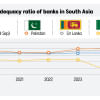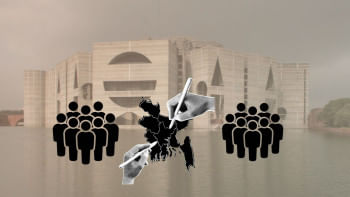Issues our banking sector must address

The contribution of the banking sector to the economy of Bangladesh is enormous as most of our economic sectors depend heavily on banks for their financial requirements. However, such dependence has created many problems for the banking sector and its depositors.
Commercial banks are supposed to provide small and short-term loans. Small loans can bring in many borrowers, which helps the bank construct a well-diversified portfolio. Short-term loans increase turnover that helps increase profit. But our banks do exactly the opposite within the legal framework. For example, if a bank is permitted to grant a loan of up to 25 percent of its capital to finance power sector projects, only four such borrowers could take up all the capital of the bank. The failure of these borrowers to repay will put the bank at risk for insolvency.
Generally, a bank can grant a borrower 15 percent of its capital as funded loans and 20 percent as non-funded loans. As such, a borrower can get a loan that is up to 35 percent of the bank's capital. If there are three such borrowers, they can consume the bank's entire capital. And if they default, the bank will collapse.
In addition, by granting large loans, banks fail to construct a well diversified portfolio of investment that can show a proper balance between risks and returns. These larger loans are also concentrated in certain sectors. For example, the ready-made garment (RMG) sector gets a good portion of large bank loans.
In the past, to write a loan off, it needed to remain unpaid for five years, a 100-percent provision needed to be maintained, and a case was required to be filed against the borrower. But recently, the loan write-off rule has been changed by reducing the unpaid period of an NPL from five to three years. This allows banks to erase traces of their worst loans from the balance sheet quickly.
Because of the availability of large and long-term loans, our stock market has not grown the way it should have. Borrowing funds from banks is easier than raising funds from the share market, because when funds are borrowed, borrowers are directly accountable to the banks, not to depositors. Hence, there is no pressure from depositors on the borrowers who default. But in the stock market, borrowing firms have to win over investors—the suppliers of funds—with their performance in terms of share prices. Banks, on the other hand, can be easily convinced by less creditworthy borrowers.
When banks provide large and long-term loans from their short-term deposits, it imposes major risks on their stakeholders, primarily the depositors. The failure of one major borrower can put hundreds of small depositors at risk. Granting large loans to finance projects goes against the basic principle of bank lending as they create maturity mismatch issues, wherein depositors' claims to banks mature earlier than banks' claims to borrowers. This inequality also creates liquidity problems and banks fail to honour customers' cheques. Large loans are also more likely to be defaulted and decrease the opportunity for banks to make profit. Therefore, single-borrower exposure should be restructured. Large and long-term loans from banks should be restricted so that firms turn to the stock market.
The capital base of Bangladeshi banks is relatively low compared to that of banks in other Asian countries. This is partly because of our bulk of non-performing loans (NPLs) and partly due to low reinvestment of profits. Against these NPLs, banks have to keep provisions, which come from profit. High NPLs have a direct impact on banks' profits. After keeping provision, profit is divided into two parts: dividend and retained earnings. Bank owners are more interested in taking profits as dividends rather than reinvesting them as retained earnings, even though the latter can contribute insignificantly to the formation of a capital base.
Banks in Bangladesh have also been given undue benefits with the frequent changing of loan classification rules. In order to reduce the irresistible growth of NPLs, the loan classification rule was relaxed, deviating from the international standard. In addition to loan rescheduling—term extension, interest waiver, and further borrowing—loan restructuring benefits were allowed for a group of large borrowers with loans of Tk 500 crore and above on a minimum down payment of the outstanding loans. And these borrowers did not regularise their loans after receiving such leniency. Ultimately NPLs soared, breaking all records.
To note, when NPLs rise, there are huge political repercussions. And though there is less of a fuss regarding write-off loans, a write-off loan is the worst state of NPLs. In the past, to write a loan off, it needed to remain unpaid for five years, a 100-percent provision needed to be maintained, and a case was required to be filed against the borrower. But recently, the loan write-off rule has been changed by reducing the unpaid period of an NPL from five to three years. This allows banks to erase traces of their worst loans from the balance sheet quickly. Thus, to reduce NPLs, rather than relaxing the related policies, proper steps need to be taken before and after sanctioning loans. Rescheduling and restructuring of loans must be made purely based on economic reasons. These will improve the overall condition of the banking sector.
There is also continuous capital flight from rural to urban areas. Bangladesh Bank data shows that even though rural areas supplied 12.93 percent of deposits in 2010, they obtained only 8.04 percent of advances. The supply of deposits by rural people rose appreciably to 21.57 percent in 2022, but they obtained only 10.33 percent of advances—a capital flight by 11.24 percentage points to urban areas. The misuse of loans by wilful defaulters from urban areas creates a disproportionate threat for rural depositors. To counter this, more scope for using loans in rural areas should be created.
Although Bangladesh's banking sector has made considerable improvements in expenditure management, its spending is still high. Bangladesh Bank data shows that the expenditure-income ratio was around 99 percent on average between 1991 and 2000. It declined considerably to 73 percent in 2010 before increasing to 78 percent in 2022. This high ratio may be attributed to lofty pay for staff, provision for classified loans, and high corporate tax rates. This expenditure preference tendency of banks should be controlled because high expenditures are mainly off-set against low pay to depositors.
The existence of 61 banks in the country has still failed to bring the expected number of people under the banking network. The poor are less interested in maintaining financial relationships with banks. Some private banks even discourage small depositors from opening accounts with them. But why should a good portion of the urban poor still keep their money in semi-formal and informal repositories when we have a good number of banks?
Dr Md Main Uddin is professor and former chairman of the Department of Banking and Insurance at the University of Dhaka. He can be reached at [email protected].
Views expressed in this article are the author's own.
Follow The Daily Star Opinion on Facebook for the latest opinions, commentaries and analyses by experts and professionals. To contribute your article or letter to The Daily Star Opinion, see our guidelines for submission.

 For all latest news, follow The Daily Star's Google News channel.
For all latest news, follow The Daily Star's Google News channel. 











Comments